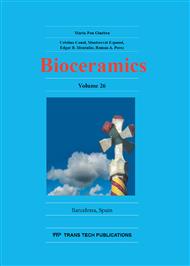[1]
A. Hoppe, A.R. Boccaccini, in: P.A. Netti (Ed. ), Biomedical Foams for Tissue Engineering Applications, Woodhead Publishing, 2014, pp.191-212.
DOI: 10.1533/9780857097033.2.191
Google Scholar
[2]
M.N. Rahaman, in: A.R. Boccaccini, P.X. Ma (Eds. ), Tissue Engineering Using Ceramics and Polymers (Second Edition), Woodhead Publishing, 2014, pp.67-114.
Google Scholar
[3]
J.R.J. Delben, K. Pereira, S.L. Oliveira, L.D.S. Alencar, A.C. Hernandes, A.A.S.T. Delben, Journal of Non-Crystalline Solids 361 (2013) 119-123.
DOI: 10.1016/j.jnoncrysol.2012.10.025
Google Scholar
[4]
Z. Ma, H. Ji, X. Hu, Y. Teng, G. Zhao, L. Mo, X. Zhao, W. Chen, J. Qiu, M. Zhang, Applied Surface Science 284 (2013) 738-744.
DOI: 10.1016/j.apsusc.2013.08.003
Google Scholar
[5]
Y. -Z. Liu, Y. Li, X. -B. Yu, L. -N. Liu, Z. -A. Zhu, Y. -P. Guo, Materials Science and Engineering: C 41 (2014) 196-205.
Google Scholar
[6]
X. Chatzistavrou, E. Kontonasaki, K.M. Paraskevopoulos, P. Koidis, A.R. Boccaccini, in: P. Vallittu (Ed. ), Non-Metallic Biomaterials for Tooth Repair and Replacement, Woodhead Publishing, 2013, pp.194-231.
DOI: 10.1533/9780857096432.2.194
Google Scholar
[7]
Q. -Z. Chen, Y. Li, L. -Y. Jin, J.M.W. Quinn, P.A. Komesaroff, Acta Biomaterialia 6 (2010) 4143-4153.
Google Scholar
[8]
A. Lucas-Girot, F.Z. Mezahi, M. Mami, H. Oudadesse, A. Harabi, M. Le Floch, Journal of Non-Crystalline Solids 357 (2011) 3322-3327.
DOI: 10.1016/j.jnoncrysol.2011.06.002
Google Scholar
[9]
A. Balamurugan, G. Sockalingum, J. Michel, J. Fauré, V. Banchet, L. Wortham, S. Bouthors, D. Laurent-Maquin, G. Balossier, Materials Letters 60 (2006) 3752-3757.
DOI: 10.1016/j.matlet.2006.03.102
Google Scholar
[10]
A. Perardi, M. Cerrruti, C. Morterra, in: C.C. Aldo Gamba, C. Salvatore (Eds. ), Studies in Surface Science and Catalysis, Elsevier, 2005, pp.461-469.
Google Scholar
[11]
J. Du, Y. Xiang, Journal of Non-Crystalline Solids 358 (2012) 1059-1071.
Google Scholar
[12]
E. Gentleman, Y.C. Fredholm, G. Jell, N. Lotfibakhshaiesh, M.D. O'Donnell, R.G. Hill, M.M. Stevens, Biomaterials 31 (2010) 3949-3956.
DOI: 10.1016/j.biomaterials.2010.01.121
Google Scholar
[13]
M.D. O'Donnell, R.G. Hill, Acta Biomaterialia 6 (2010) 2382-2385.
Google Scholar
[14]
C. Wu, Y. Zhou, C. Lin, J. Chang, Y. Xiao, Acta Biomaterialia 8 (2012) 3805-3815.
Google Scholar
[15]
A. Gorustovich, T. Steimetz, R.L. Cabrini, J.M. Porto López, Bone 41 (2007) S4.
DOI: 10.1016/j.bone.2007.09.015
Google Scholar
[16]
N. Lotfibakhshaiesh, E. Gentleman, R. Hill, M. Stevens, Clinical Biochemistry 44 (2011) S36.
Google Scholar
[17]
S.M. Salman, S.N. Salama, H.A. Abo-Mosallam, Ceramics International 38 (2012) 55-63.
Google Scholar


